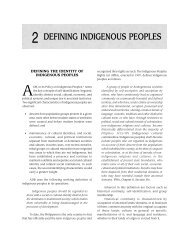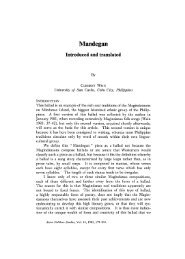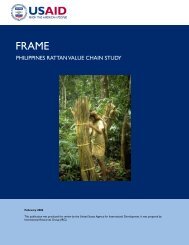Indigenous Music - Philippine Culture
Indigenous Music - Philippine Culture
Indigenous Music - Philippine Culture
Create successful ePaper yourself
Turn your PDF publications into a flip-book with our unique Google optimized e-Paper software.
Other idiophones of the South include the gabbang or bamboo xylophone of the Tausog of<br />
Sulu, and the edel or log drum, a plank idiophone made of molave wood suspended and beaten with sticks<br />
and used by the Tabakaolo, Bilaan and Manobo.<br />
Probably the most important and best known membranophones of the North are the two<br />
conical drums of the Ibaloi – the sulibao and the kimbal. The sulibao has a higher pitch than the kimbal and<br />
is played with a padded stick. Usually, however, these instruments are joined by two other pairs of<br />
idiophones in the sulibao ensemble, namely, the kalsa and the pinsak, which are two flat gongs, and the<br />
palas which are two short iron bard handled by a single player. Similar types of drums exist in the South<br />
such as the dabakan of the Maguindanao and the dadabuan of the Maranao. In addition to these conical<br />
drums, cylindrical types of drums are exemplified by the tambul of the Maguindanao and the gimbal of the<br />
Tagbanua.<br />
Like the instruments, vocal music expresses and transmits in a concrete and vivid manner a<br />
great variety of the thoughts, beliefs, customs, lifestyles, temperament and way of life of the indigenous<br />
peoples. Singing is a main component of life among them. There will be songs and singers, singing solo or in<br />
leader-chorus style with or without accompaniment, with or without the benefit of words (the latter includes<br />
whistling, a highly developed musical from among the Maguindanao of Mindanao).<br />
Solo and leader-chorus singing is done in the North, notably in such groups s the Bontoc,<br />
Ibaloi, Kalinga and Negrito. In the South, on the other hand, while unaccompanied singing seems to be the<br />
predilection of a majority of the indigenous groups, a kind of singing done with instrumental accompaniment<br />
is practiced among certain groups, like the Tausog, who sing with their gabbang (bamboo xylophone) and/or<br />
biola.<br />
Both types of singing – the leader-chorus and singing with instrument – may be found in the<br />
Central <strong>Philippine</strong> groups such as the Mangyan and Tagbanua, where often singing is done with the flute<br />
(Tagbanua), the guitar or violin (Mangyan), either solo or as a group with a soloist-leader.<br />
One may be observe a highly divergent and seemingly endless variety of styles and traditions<br />
of singing in the northern, central and southern <strong>Philippine</strong> indigenous communities. For example, the Kalinga<br />
of the North generally sing in short phrases frequently broken by rests or stops; the Maguindanao of the<br />
south sing in long melismatic phrases; the Mangyan sing mostly in a monotone with turns at the end of<br />
phrases.<br />
Viewed as a whole, certain patterns and<br />
characteristics of singing emerge among these groups. First,<br />
improvisation seems to be the rule in song creation. In fact<br />
the quality of the song and the singer if often measured by<br />
his/her ability to improvise fluently and creatively. Second,<br />
there is generally a low and limited range of notes (more or<br />
less an octave) and within this range, a great number of<br />
uncertain pitches, speech-like sounds, slides, shakes,<br />
tremolos or trills are often added to bring about some<br />
flexibility and richness in the singing despite the narrow<br />
range. Third, melodic ornamentations such as the glissandos,<br />
slides and tremolos are not only accessory but principal<br />
elements in music because they may even determine the<br />
structure of a song. Fourth, since everyone is a singer, there<br />
is a greater variety of voice quality due to differences in age,<br />
sex or cultural factors (e.g. the Manobo sing in a more<br />
relaxed manner and with more embellishments than the<br />
Tiruray). Fifth, a wide variety of scales may be observed. The<br />
scale, however, is, often treated as a flexible structure upon<br />
which equally important elements are embedded to adorn the<br />
scale and render it less obvious. Sixth, while decrescendos<br />
and crescendos (gradual decrease and increase in volume,<br />
respectively) and up and down movements may be noted in<br />
the singing styles of some groups especially in the South, a<br />
syllabic chant-like monotone singing prevails in<br />
many groups. Chanting utilizes the vocal range of a singer<br />
which is most consistent with his natural speech melody. This is the reason why sometimes it is difficult to<br />
discern whether a particular enunciation is sung or uttered. Seventh, there are no exact time elements that

















